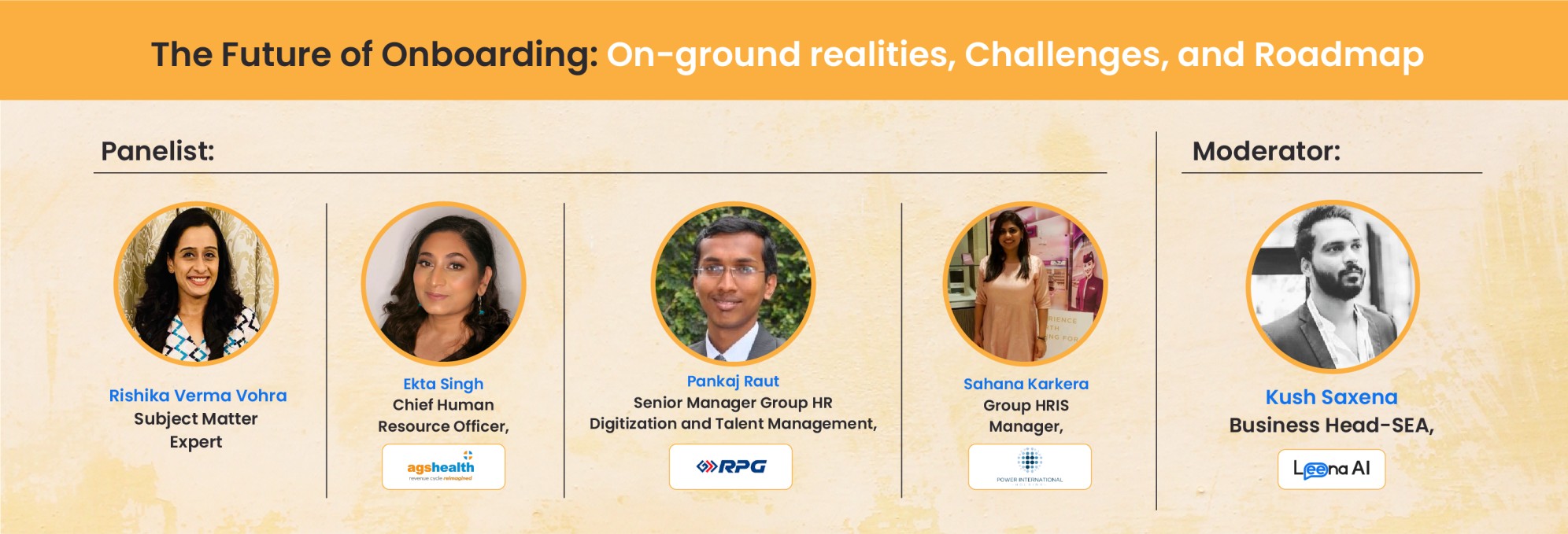In the past two years, organizations of all sizes — from SMEs and startups to enterprises with 10,000+ employees — have each been undergoing an operational transformation. In this scenario, the future of employee onboarding has emerged as a process of focus.
Our South East Asia Business Head, Kush Saxena recently spoke to an esteemed panel of HR juggernauts and dug deep on these questions in an exclusive webinar attended by senior HR leaders and key onboarding decision-makers from India, Middle-east, and Southeast Asia.

Questions in focus
- Why has the future of employee onboarding become a key focus for HR leaders?
- How will AI and digital transformation change the onboarding process?
- What are the key benchmarks that will determine a successful onboarding workflow?
The session that followed sets clear precedence and builds a roadmap every organization can implement. Here are the key takeaways.
Artificial Intelligence will set a new paradigm in hiring and retaining new employees
While personalization and customization are important, it is important for HRs to also focus on reducing the overall turnaround time in the future of employee onboarding. But with the volume of hiring rising, scaling up existing processes without losing out on the human element is a tedious task.
According to Sahana Karkera, Group HRIS Manager at Power International Holding, artificial intelligence is the future of the onboarding process, as it can meet the demands for scaling and engagement. From application to the window between selection and day one, AI can fast-track the process and reduce turnaround time. “People will not wait six months to hear back from you. Therefore, to make the process shorter and hassle-free, digitalizing the entire process is crucial,” she said.
She gave the following workflow as an example of how AI and digital tools can reduce turnaround time:
When the candidate tries to apply for a position, they just need to attach their CV. The profile is auto-created through parsing, rather than having the candidates sit and type in that information. They are also able to check the status through notifications and real-time updates. They can see the progress of their application, figure out important dates, and sometimes even suggest similar roles they can apply.
“We cannot achieve these things unless we have automation in place. Because it’s humanly not possible with the volumes that we handle. So using AI and automation is essential, whether it is shortlisting of CVs or application management,” Sahana concluded.
Ekta Singh, CHRO, AGS Health, believes that investing in predictive tools is crucial. She also feels that HRs need to permutate and automate onboarding processes based on priority. For example, policies and processes that do require human intervention can be automated through AI-powered offerings like Leena AI.
NLP-based documentation generation and FAQ resolution is another aspect Ekta Singh highlighted. “I remember while using Leena AI and when you type in ‘I’m not happy today,’ the chatbot can say—What can I do to help?” she said. “And you give them a series of questions—Is it learning? Are you not enjoying work? Is it your supervisor? Is it a promotion? Is it performance? There are many aspects that you can learn about an individual from a set of questions given in the right manner and then analyzing the data,” she added.
Regarding data, Pankaj Raut, Senior Manager – Group HR Digitization and Talent Management, RPG Enterprises, elaborated on the need of improving the metrics analyzed. “I think we have this habit of measuring a lot of KPIs. But oftentimes, we do not intend to improve on what we are measuring. I think it’s very critical to focus on improvement,” he summarized.
Cookie-cutter onboarding processes will no longer work. A personalized scalable onboarding model needs to be implemented
Traditional onboarding processes relied on a one template fits all approach. But, in the future of employee onboarding, with job roles and workflows diversity, the uniqueness of job roles and tiles getting created is increasing.
According to Ekta Singh, this means that hiring for such roles will require a shift towards more personalized onboarding. Each employee will need a bespoke onboarding process that matches their notice period, career goals, and expectation from the company.
Rishika Verma Vohra, the subject matter expert, mirrored the same thought. According to her, HR leaders must analyze their employee demographic and focus on engaging them suitably. “There has to be a sense of belonging that is created,” she said and stressed the importance of making them feel a part of the organization, right from the moment they sign the offer letter.
Resolving the disconnect between hiring and onboarding will require a top priority
Digital transformation and AI-powered workflows have revolutionized various aspects of the HR process. However, there is still a flavor of heterogeneity in the overall onboarding experience. This is something Pankaj Raut has noticed in his analyses. As a result, he underlined the gravity of making employees feel part of a bigger ecosystem. “It is important to ensure that a person feels he is not joining just a particular department, or a team, or a location. They have to sense a belonging towards a vibrant community,” he added.
To bridge the gap between hiring and onboarding, Sahana Karkera suggests streamlining the systems that govern the processes. She emphasized the significance of making sure that the employee hiring procedure, onboarding touchpoints, and the induction of the employee in the system are executed like clockwork. Here are the three points she suggested to get the bridgework started:
- Sensitizing the candidate on the various milestones of the onboarding process
- Tightening coordination channels between concerned departments
- Providing easy query resolution
The demand of the moment is to look at the process from an employee’s point of view. According to Pankaj Raut, the talent acquisition team needs to understand that for the employee it is one department. “The employee or the end-user is not thinking in terms of the onboarding team, recruitment team, or some HR business partner. So we need to have a very well-structured process that consolidates every process flawlessly,” he said.
Face Value Impressions will need to meet on-reality expectations
When employees apply to an organization, it is usually based on the company’s online reputation or word-of-mouth impression. What happens on the ground, needs to match these expectations. This aspect is especially important with the ongoing wave of great resignation.
Rishika Verma’s strategy to tackle this was to understand the psyche of the employee joining the organization. It is crucial to know that the new talent is undergoing a blend of emotions. She explained that “it is very important to have regular conversations and engagements…The process needs to be personalized and dependent on the stakeholders involved.”
However, she also cautioned that personalization according to expectations should never be a pivot for granting exceptions to new hires. According to her, even if the internal team wants the fresh talent to be joined, HRs will need to communicate SLAs effectively. Trimming out touchpoints to meet expectations is great, but it should never compromise the structure.
For example, an organization may want to onboard a candidate immediately. But it should never come in the way of preset verification and compliance procedures. “Even if we say no three months notice or two months verification, this is what it is, it may have seeding issues, but it will eventually lead to a very strong and structured organization,” she emphasized.
To reduce dropout rates, HRs will need to walk the fine line between personalization and structure
The great resignation was the lead-in footnote to the post-COVID offices. As some employees returned to the offices, many saw their colleagues send in their resignation letters. This presents a double-edge opportunity for HRs: one, new talent is up for grabs, but on the other hand, they are pickier than ever. If they are not onboarded or engaged properly, chances of dropoffs rise exponentially.
Ekta Singh suggested that organizations should switch their onboarding process from a monologue to a dialogue. It will no longer be enough to send a mail with instructions and check-boxes. The hiring process needs to account for new thoughts, opportunities to propose ideas, and opinions.
This means that articulate communication will be the cornerstone of successful onboarding in the coming days. From the first introductory call, a candidate should be given a roadmap that includes everything from the number of interviews to who they will meet on day one. “We’re not thinking of one HR department. We need to start thinking in terms of the HR team as one single entity. It doesn’t matter where the handoff is and where the takeoff is. Everything should be seamless,” she added.
Work-life balance has become an important yardstick by which new hires judge a company. Sahana Karkera has noticed this in her experience with new members that joined her teams in Qatar. She found that initially, joiners found it difficult to adapt. Factors include a shift in culture, new processes, and a fast-paced working environment. “But if you have the right support, interactive engagement, immersive training management, and leadership support, people will tend to stay longer,” she said. “The employee doesn’t leave the organization, they leave the manager.”
Rishika Verma believes that employee engagement plays a central role in retaining employees and meeting expectations. The higher the position, the greater the need to engage, she said.
The moment an offer is sent out to the candidate, it should not just be the recruiter who is reaching out. Relevant stakeholders need to touch first base with the new hire before they are bombarded with inbox and documentation emails. “It is always good that you speak to the person first before they see an email. They might be caught unaware and even flag it as spam.”
Watch the complete session
Onboarding in the New Paradigm
The stage is set for a revolution in employee onboarding through AI and other emerging technology. HRs are at the precipice where they must leap to a digital-first future, without losing the human element. The shift in the future of employee onboarding will lay greater emphasis on providing immersive onboarding experiences that delight new hires. The situation will also gear towards a workflow that looks at onboarding as a continuous process, rather than siloed tasks. Centralization and engagement through AI are going to be the keyword of the future.







3 Comments